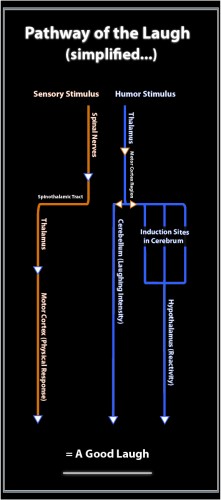What prompts laughter? As you may know, nearly anything can: a friend’s joke, a tickle, a memory, an uncomfortable situation or even a laugh itself. Although laughter may seem to be a simple, nearly reflexive reaction to these triggers, the neurological processing behind humor cognition and laughter expression is extraordinarily complex, and largely unknown. Our biological machinery is not designed with frivolity in mind, so pleasure alone cannot account for why we laugh, and its evolutionary advantages are under debate. In this article I will discuss some of the more prominent theories in gelotology, regarding laughter’s neurobiology and adaptive uses.

Let’s start with the seemingly basic touch induced laughter–though even here the physical process is unclear. Our skin contains several sub-cutaneous receptors, each of which are specialized to respond to different touch sensations: light and deep pressure, heat, vibration, etc. Tickling is a “complex” touch that simultaneously activates several types of these receptors, which translate the sensation’s different components into electrical signals. For scientists, the big question is whether tickling is processed as more of an “itch” or a “touch” (2). Different touching sensations are transmitted via different pathways, so scientists must know which and what proportion of receptors are recruited during tickling in order to understand the actual route taken to produce the behavioral outcome of laughter.
Generally, these electrical signals generated by the touching sensations travel through the spinal nerves, then the dorsal horns of the spinothalamic tract and ultimately the “relay station” known as the thalamus. Here, the signal can be sent to a number of brain regions, depending on the original stimulus. For tactile inputs, the thalamus sends the signal to the somatosensory cortex (2). From there, the familiar motor behaviors, vocalizations and respiratory changes are controlled by the motor cortex, certain languages centers and pontine centers (in connection with a few others), respectively. “Self-tickling” is prevented by a hindbrain structure called the cerebellum, which is capable of predicting the specific sensory consequences of anticipatory movements, granting the signal that is used to negate the sensory response to self-generated stimulation (4).

Laughter invoked by humor, however, requires higher computing and thus the inputting signal will be sent via the thalamus to additional brain areas. Investigation of the cerebral correlates of “higher order” humor have been impeded by a lack of consensus among psychologists on what precisely humor and its necessary components are (3). From what is established, however, it’s thought that the emotional context of a comical event is processed by the ventromedial prefrontal cortex, the anterior cingulate cortex, the extended amygdala, and the ventral striatum (5). These “induction sites” exert their influence on additional effector sites, like the hypothalamus, the periaqueductal gray matter, the cranial nerve nuclei, and premotor regions to generate the displayed reactionary behavior (4). The cerebellum is believed to adjust our laughing intensity to different social or cognitive contexts, in addition to blocking a self-induced tickling response. Of course, during any given laughing event, these areas demonstrate variable levels of activation depending on innumerable factors, such as an individual’s preexisting mental state or “definition” of humor (for example, does this person find violent acts like getting hit by a baseball bat hilarious? If so, this may involve more amygdala activation), the actual social setting, and so forth.
So why do we laugh? Well, strangely enough, no one knows for sure. Of note, research has shown that laughing is absolutely crucial in establishing and maintaining normal social interactions across cultures. While smiling emerges roughly 5 weeks after birth (13), babies can laugh as early as 2-4 months old, even before they begin to speak (3). Since our initial and primal trigger, tickling, requires physical contact, it’s theorized that laughter is adaptive for social bonding (1). Tickling is a pleasurable experience for babies, so they learn to associate physical contact positively, which promotes trust-building and normal social development. It is also believed that pointing out and making the child “aware” of sensitive and vulnerable bodily areas helps us acquire our defensive skills. It’s probably no coincidence that prime “ticklish” areas (stomach, armpits, genitals, neck, so forth) are major reflexively “protective” areas, and in our youthful rough-and-tumble play we are concurrently improving our self-awareness.
Later in life, laughter exchanges and patterns may even relate to mate-seeking or sex play behavior (1). Gender differences exist with laughing frequency: although both males and females develop “joke-telling” skills at roughly the same age (5 or 6 years old) across cultures, studies have found that in cross-gender conversations, females laughed 126% more than their male counterparts (1). Additionally, beginning around puberty, reciprocated tickling occurs more often between opposite, non-stranger sexes. The act of laughing, whether or not it is genuine, alleviates stress, and is widely understood to secure and comfort social intercourse (8). This is why we nervously laugh, even during inappropriate moments: our body copes with stressful scenarios by automatically engaging in an action that is guaranteed to ease internal and external tension. Reduced stress, in turn, attenuates the production of chemicals like adrenaline, which increases our heart rate and blood pressure, and cortisol, which suppresses our immune system and is actually neurotoxic. It also stimulates the production and responsiveness of tumor- and disease-killing cells such as Gamma-interferons and T-cells.
All of these advantageous reasons for laughing certainly hold true with other species: rats, dogs, and primates can laugh (9,10,14), and do so for the purposes of social expression and bonding. Rats and primates laugh during wrestle-play, and dogs commonly laugh in pro-social situations or in shelters to calm themselves. Of course, the vocalizations themselves may sound very different across animals– for example, rats vocalize at a frequency higher than our audible range, and chimpanzees express laughter by panting because they lack the breath control that humans have. Hearty laughing improves respiratory function, cardiac output, and stretches abdominal muscles. The deep, intense gasping of laughter helps stabilize our breathing, and heavy laughter actually causes significant heart rate elevation in minimal time: 10-15 minutes of laughter can burn up to 50 calories (15). In addition to lowering stress and bolstering relationships, laughing is reinforcing: the ventromedial prefrontal cortex is strongly affiliated with hedonic perception (6), the ventral striatum is implicated as a reward center (7), and the periaqueductal grey matter controls descending pain modulation (12).
Laughing is an ancient behavior for us, and is one of the most primitive engagements to have carried over for thousands, if not millions, of years. And although we’ve pondered its cause and reason since the days of Aristotle, it has only been formally studied in the past few decades. As such a deeply moving and pleasurable experience though, perhaps it comes as no surprise to learn the profound and and diffuse neurological networking in its generation. In addition, to what has been covered above, lesion and stimulation studies have also revealed a host of other areas involved in mirthful experience (3), and I urge you to read the literature for more information. For now, despite the holes in out body of knowledge on laughter, it can be enjoyed simply for what it is.
_________________________________________________________________________________________
References
1. Provine, RR. (2004) Laughing, tickling, and the evolution of speech and self. Current directions in Psychological Science. 13(6): 215-18.
2. Selden, ST. (2004). Tickle. Journal of the American Academy of Dermatology. 50(1): 93-97.
11. Vlachopoulos C, Xaplanteris P, Alexopoulos N, Aznaouridis K, Vasiliadou C, Baou K, Stefanadi E, Stefanadis C. (2009). Divergent effects of laughter and mental stress on arterial stiffness and central hemodynamics. Psychosom Med. 71(4):446-53.
12. Loyd, DR; Murphy, AZ. (2009). The Role of the Periaqueductal Gray in the Modulation of Pain in Males and Females: Are the Anatomy and Physiology Really that Different? Neural Plasticity, Article ID 462879, 12 pages.
13. Kraemer, M, Abrahamsson, M, Sjostrom, A. (1999). The neonatal development of the light flash visual evoked potential. Doc Ophthalmol, 99: 21-39.
14. “Tickled apes yield laughter clue”, News.BBC.co.uk, June 4, 2009.
15. M S Buchowski, K M Majchrzak, K Blomquist, K Y Chen, D W Byrne and J-A Bachorowski. (2007). Energy expensiture of genuine laughter. International Journal of Obesity (31): 131-137.


One Comment on “Scientists Just Don’t Get It: The Complexities of Laughter”